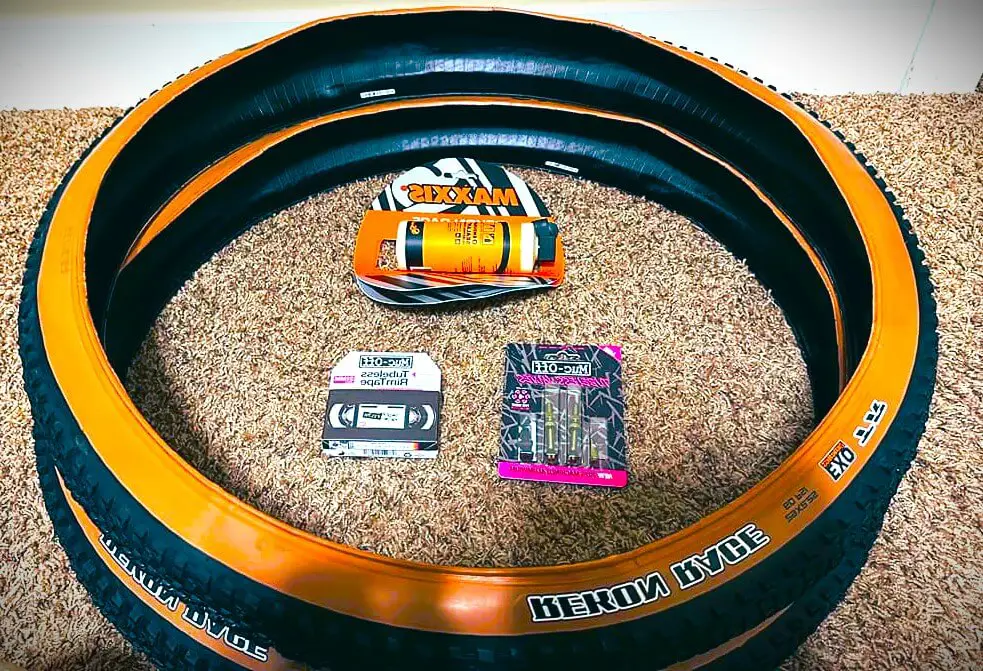23mm vs 25mm Tires – Cyclists’ Perspective

As an affiliate, we may earn from qualifying purchases. We get commissions for purchases made through links on this website. You can read more on our Affiliate Disclaimer here.
Are you tired of constantly debating between 23mm vs 25mm tires for your bike?
Then, get ready to pedal into the world of tire technology as I dive deep into the age-old question which one is better?
23mm and 25mm tires differ in their performance balance. 23mm tires are favored for racing due to their agility and aerodynamics.
They are also more durable and offer better traction. For extended rides and varied terrain, 25mm tires sacrifice speed for comfort and versatility. In the end, it comes down to personal preference and the conditions.
Here, I’ll compare their performance, comfort levels, pros- and cons, and overall suitability for different types of terrain. So grab your helmet and uncover the mystery behind these two popular tire sizes!
An In-Depth Look at 23mm Tires
Usually, 23mm tires are specialized for road cyclists who want speed and performance. But they sacrifice comfort and adaptability on less-than-ideal roads.
Due to their narrow width, 23mm tires have lower rolling resistance. As a result, speed enthusiasts and road racers love them.
As a result of this lower resistance, pedaling is more efficient, and speed is increased. Moreover, their slender build reduces frontal area, which enhances aerodynamic efficiency.
Despite these gains in speed, higher air pressure results in a harsher ride.
The direct handling of 23mm tires appeals to riders seeking precision on the road. It is essential to balance this attribute with rider comfort preferences and terrain.
A rider’s objectives and conditions should dictate the choice of these tires.
Benefits Of 23mm Tires
Drawbacks Of 23mm Tires
- Harsh Ride on Rough Roads
- Limited Comfort
- Less Traction on Uneven Terrain
- Declining Market Availability
An In-depth Look at 25 mm Tires
There is no doubt that 25mm tires are a versatile and popular option in the world of road cycling. Despite their moderate width, they are suitable for many riders and conditions.
With 25mm tires, you can choose between narrow, high-speed options and wider, more stable ones.
Although they do not have the low rolling resistance of 23mm tires, they are still ideal for long-distance rides. As a result, they are versatile for a variety of road conditions.
With Fender compatibility, 25mm tires can be easily installed on most road bikes.
Compared to narrower tires, they provide a more stable and comfortable ride. Cycling athletes, commuters, and endurance riders enjoy their added comfort, especially on less-than-ideal surfaces.
For those looking to adapt their bike for different uses, they are a practical choice.
Benefits of 25mm Tires
Drawbacks of 25mm Tires
- Slightly Higher Rolling Resistance than Narrower Tires
- Limited Aerodynamic Advantages
- Not as Speed-Focused as 23mm Tires
- May Require More Tire Clearance than Wider Options
23mm vs 25mm tires: Comparison Chart
An overview of the two most popular tires is provided in the following table. The chart below shows the key differences between 23mm and 25 mm tires. Please review the chart below!
| Comparison Analysis | 23mm Tires | 25mm Tires |
| Rolling Resistance | Lower, ideal for speed | Slightly higher, but a good balance |
| Aerodynamics | More comfortable, and suitable for mixed surfaces | Good, with a slight reduction in drag |
| Comfort on Rough Roads | Better acceleration due to a lighter load | More comfortable, suitable for mixed surfaces |
| Weight | Slightly lighter | Slightly heavier |
| Handling | Precise and direct | Balanced and stable |
| Terrain Suitability | Best on smooth roads and racing circuits | Versatile, suitable for various terrains |
| Traction | Lower due to narrower profile | Better traction on mixed surfaces |
| Market Availability | Declining due to reduced demand | Widespread availability |
| Installation Ease | Easier due to narrower profile | Easy to install, fits most frames |
| Long-Distance Comfort | May feel harsh on extended rides | More comfortable for long-distance cycling |
| Air Pressure | Higher minimum air pressure | Lower minimum air pressure |
| Acceleration | Better acceleration due to lighter load | Slightly slower acceleration due to increased tire volume |
| Speed | Potentially faster on smooth roads | A good balance between speed and comfort |
Examining The Differences Between 23mm vs 25mm Tires
One of the crucial decisions that cyclists often grapple with is the choice between 23mm and 25mm tires.
In spite of both options having advantages, exploring the differences can be helpful for making an informed choice. Let’s roll on!
Rolling Resistance
A cyclist’s rolling resistance affects speed, efficiency, and overall riding experience. Typically, 23mm tires perform well due to their narrower profile, resulting in less friction.
In competitive road racing, small efficiency gains can make a big difference.
Conversely, 25mm tires balance speed and comfort while slightly increasing rolling resistance.
Their more comprehensive profile provides a more comfortable ride for longer distances and various road conditions.
Aerodynamics
23mm tires have a narrow profile that helps reduce frontal area and minimizes air resistance. As a result, they are particularly well-suited for racing scenarios.
Due to their outstanding aerodynamic properties, 23mm tires are preferred by competitive road racers.
For sprints and breakaways, cyclists need tires that allow them to maintain high speeds quickly.
On the other hand, 25mm tires balance aerodynamics with comfort, though they aren’t as aerodynamic as narrower tires.
The slightly wider profile creates a slight increase in air resistance compared to 23mm tires. These tires offer versatility for various road-riding scenarios.
Aerodynamically, they may be better than 23mm tires, but they provide better comfort on rough roads.
Comfort on Rough Roads
Because 23mm tires have a narrower profile, they have a more minor contact patch with the road. As a result, they are less forgiving on rough roads due to their limited contact area.
Since 23mm tires require more air pressure to maintain their shape, cyclists may experience more vibrations. The rigid ride can lead to discomfort during long rides on challenging terrain.
On the contrary, 25mm tires are more comfortable on rough roads due to their slightly more comprehensive profile.
It improves shock absorption and reduces vibration, resulting in a smoother ride. These tires are ideal for cyclists who experience mixed surfaces, potholes, or uneven terrain on their rides, as they are versatile.
Weight
As 23mm tires are narrower and use less material, they can be marginally lighter than their 25mm counterparts.
Some cyclists, such as competitive road racers, prefer 23mm tires to gain a slight weight advantage.
Generally, 25mm tires are slightly heavier than 23mm tires due to their increased tire volume and additional material.
25mm tires may add a little weight, but the difference is often inconsequential for recreational riders.
Height
The overall tire height is typically lower on 23mm tires. This lower profile can contribute to a slightly more aggressive and responsive feel when cornering or steering.
Competitors may prefer 23mm tires for their lower profile as they enhance aerodynamics and can improve the bike’s appearance.
Alternatively, 25mm tires exhibit a moderate height compared to 23mm tires. With this height, they provide a balance between comfort and responsiveness.
Cyclists seeking additional cushioning and a more forgiving ride often opt for 25mm tires. The moderate tire height contributes to improved shock absorption on rough roads.
Terrain Suitability
23mm tires excel on well-maintained, smooth roads. A narrow profile makes them ideal for high-speed riding and road racing, where pavement quality is excellent.
They may struggle on rough or uneven terrain due to reduced shock absorption.
In contrast, 25mm tires are more adaptable to varying road conditions. They offer a smoother ride on moderately rough roads.
Thus, they suit urban commuting, city trails, and mixed road surfaces. With 25mm tires, cyclists encountering potholes or gravel sections can gain increased comfort and stability.
Traction
On well-maintained roads, 23mm tires offer decent traction on dry. They may be less suitable for rainy weather because their more minor contact patch reduces traction and cornering grip.
However, 25mm tires provide improved traction due to their more comprehensive profile and increased contact patch.
As a result, they are more dependable in dry and wet conditions. With 25mm tires, cyclists benefit from enhanced traction in weather conditions and mixed road surfaces.
Installation Ease
23mm tires, being narrower, can be slightly more challenging to install and remove from rims. Their smaller profile may require more effort and care during the tire-changing process.
The ease of installation can vary depending on the specific tire model and rim combination. Some 23mm tires may be easier to work with than others.
In contrast, due to their comprehensive profile, 25mm tires tend to be more forgiving during installation and removal.
With more width, the process is easier to handle. In particular, cyclists appreciate 25mm tires when they need to replace a tire quickly or make roadside repairs.
Air Pressure
To maintain their shape and performance, 23mm tires typically require higher air pressure. On rough roads, the higher pressure can result in harsher rides.
Because Of their narrow profile, they depend on higher pressure to prevent punctures and rim deformation.
Conversely, 25mm tires can run at lower air pressure than their narrower counterparts.
With lower pressure, rides are more comfortable, especially on uneven surfaces. They are suitable for long rides and challenging terrains.
Acceleration
Due to several factors, 23mm tires often provide faster acceleration.
Due to their smaller circumference, they rotate less per pedal stroke, resulting in quicker acceleration.
However, these tires typically have less rotational mass, contributing to faster acceleration. The lighter load enhances the bike’s ability to respond promptly to pedal inputs.
Instead of 23mm tires, 25mm tires may be less quick out of the gate, although they still offer respectable acceleration.
A marginally slower response can occur due to higher tire volume and rolling resistance. It is common for cyclists who want to compromise speed and comfort to choose 25mm tires.
Speed
In smooth, well-maintained roads, 23mm tires can result in higher speeds due to their narrow profile and reduced rolling resistance.
A smaller tire width creates a more aerodynamic profile, enhancing cyclists’ speed potential.
Although 25mm tires can’t match 23mm on ideal surfaces, they offer a balanced approach.
They sacrifice minimal speed for increased comfort and versatility.
Often, cyclists choose 25mm tires when they encounter mixed roads or poor road conditions. While less blisteringly fast, they maintain good speeds while providing a smoother ride.
Are 25mm Tires Better Than 23mm?
In many situations, the 25mm tire is often considered better than the 23mm tire. With the additional 2mm width, the tire has 15% more air volume, which has several advantages.
Generally, 25mm tires provide improved shock absorption and a more comfortable ride, especially on rough or uneven terrain.
The added cushioning reduces vibrations and impacts felt by the rider.
They also offer greater versatility, making them suitable for a broader range of road conditions. They perform well both on smooth and moderately rough roads.
This makes them ideal for long-distance rides and urban commutes.
While less fast than 23mm tires on perfectly smooth roads, 25mm tires offer competitive speeds.
The reduction in rolling resistance due to their more comprehensive profile can offset any minor speed differences.
Especially in wet or slippery conditions, 25mm tires improve traction. This enhanced grip contributes to better control and safety.
For endurance cyclists or long-distance cyclists, they reduce fatigue over extended periods.
The choice between 23mm and 25mm tires leans toward 25mm because they combine comfort, versatility, and performance.
However, 23mm tires may still be helpful for top-speed racing on pristine roads.
Can I Put 25mm Tires On 23mm Rims?
Yes, it is possible to mount 25mm tires on 23mm rims. There is no problem with compatibility. But you should be cautious about exceeding this limit as it can affect tire performance and safety.
Putting 25mm tires on 23mm rims is a topic that often sparks debate among cyclists. The compatibility of tire width and rim size plays a crucial role in performance and safety.
There are some critical considerations to remember when mounting wider tires on narrower rims.
One aspect to consider is the tire’s shape when mounted on a narrower rim. When a wider tire is forced onto a narrow rim, its profile becomes more rounded than flat.
It could reduce grip and stability during cornering by altering the contact patch.
Another consideration is how your bike’s frame clearance will be affected by wider tires on narrow rims.
If your bike has insufficient clearance for larger tires, you may experience rubbing or even an inability to fit the tire.
In the end, even though 25mm tires may fit 23mm rims, manufacturers suggest choosing safe combinations based on their guidelines.
Talk to an expert at your local bike shop who can provide personalized advice based on your bike setup.
Are 25mm Tires Faster Than 23mm?
Yes, 25mm tires are generally faster than 23mm tires. Their lower rolling resistance and better aerodynamics increase speed on smooth roads. The speed difference may be marginal depending on tire models and road conditions.
Many cyclists debate the age-old question: Are 25mm tires faster than 23mm? While both tire options have their merits, it is essential to consider various factors that can impact speed.
Due to their more comprehensive profile, 25mm tires offer a more comfortable ride. It can be beneficial on uneven or rough surfaces.
However, when it comes to outright speed on smooth roads, 23mm tires have the advantage.
Especially in competitive road racing scenarios, their narrower profile reduces aerodynamic drag and rolling resistance.
There may be slight differences in speed between these two types of tires. It’s essential to consider your riding objectives and terrain before selecting. It’s ultimately up to you to decide what’s best for you.
Can I Use 700×25 Tires Instead of 700×23?
You can use 700×25 tires instead of 700×23 tires on many road bike frames. Clearance may differ depending on the model and style of the frame and fork. Here are the details:
Usually, road bike frames and forks are designed with varying degrees of clearance to accommodate different tire sizes. While some frames and forks have generous tire clearance, others may not.
In fact, On the rear wheel, you could replace a 700×23 tire with a 700×25 tire, but not on the front wheel. This is not uncommon.
It is common for the rear triangle of a road bike frame to have more clearance than the front fork. When considering a tire size change, checking front and rear clearance is crucial.
Make sure your brake calipers have clearance. Wider tires can contact the brake calipers, especially if the brakes are close to the tire. Ensure that the new tire size doesn’t interfere with your brake components.
Check your bike’s manufacturer, frame, and fork specifications for recommended tire sizes. This information can guide the maximum tire size your bike can safely accommodate.
Are Bigger Diameter Tires Better?
Usually, tire diameter selection depends on your cycling type and your specific needs. While a larger tire will provide better stability and traction, a smaller tire will be lighter and easier to handle.
Larger-diameter tires are advantageous for off-road adventures. It provides enhanced obstacle clearance, stability, and improved traction.
They also offer a smoother and more comfortable ride on rough terrain.
On the other hand, smaller diameter tires are favored for agility, ideal for fast maneuvers and competitive road cycling.
Moreover, smaller tires may be more aerodynamic and accelerate more quickly.
Your choice should align with your riding style and the terrain you encounter. By customizing your tires, you can achieve your cycling goals.
Last Words
23mm vs 25mm tires are ultimately a matter of personal preference and riding conditions.
While 23mm tires offer a more aerodynamic advantage and increased speed on smooth roads, they may need to be more comfortable on rough terrain.
On the other hand, 25mm tires provide better stability and grip, especially on wet or uneven surfaces.
Before deciding, cyclists must consider their riding style, terrain, and comfort level.
The best way to determine which size of tire suits individual needs is to test both sizes on different rides.
So why not try different tire sizes and discover the perfect fit for your cycling adventures?

Steven is a professional cyclist and his passion is cycling. He has been cycling for the last 6 years and he loves using bikes while outing as well. Based on his experiences with the different types of bikes; he is sharing his opinions about various bikes so that a beginner can start right away. Find him on Twitter @thecyclistguy Happy Biking.




